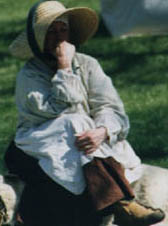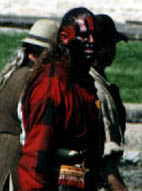Marianne Billeron, Daughter of the Mayor of Kaskaskia, Marries Francois Valle
Pioneer women had a lonely lot, not without danger. Calling 911 would not happen for 200 years.

Francois Valle, son of Charles LaVallee, was born in Beauport, Quebec,
Canada in 1716. His
grandfather, Pierre LaVallee, a surgeon, had immigrated to Quebec in 1665 from St. Saens, Dist. of Rouens,
France.
Francois had heard in Haute-Louisiane the Indians had discovered lead on top of the ground and he wanted to buy it
directly from them. But it was in an area far, far to the South near a French settlement called
Kaskaskia, in the "Illinois Country" (about halfway between Quebec and New Orleans)
in the "Upper Louisiana" or what he would have called the "Haute-Louisiane" in
Nouvelle-France (New France).
So he came down the Mississippi River and took up residence in Kaskaskia and being familiar with
commerce on the East Coast, traded and sent lead back to New York and Philadelphia. Valle's
lead was used by the Continental Army
in the American Revolutionary War.
Soon he was doing so well that he was able to marry the Mayor's daughter.
And so Francois and Marianne Billeron Valle moved from Kaskaskia, due west across the Mississippi
River to what would later bear their name, Valles Mines (in French that would mean "The mines of
the Valles" or "the mines of the Valle Family").
They lived in a log cabin built for them as a wedding present by her father Leonard Billeron. This log
cabin (now 14115 Valles Mines School Road) currently houses centuries later and continually
in use, our Lost History Museum. The rear of the house was added 124 years ago.
Eventually, gathering lead found poking out of the ground gave way to digging deeper, shallow mining close to the surface but perhaps 6 feet deep.
The early mines that Valle operated were very shallow but eventually
European deeper-mining practices would prove essential because the cave system holding the ores, got broken into segments by major earthquakes
a hundred centuries before. Mining this cave segment at 20 feet deep, because of the slanting, became the next mining cave at 30 feet deep right
next to it, as pictured in Principles of Mining 1907's
"FIG. 7.". It soon became obvious that mining required more work
than any one man could ever accomplish so Valle took to leasing the land to others. A village grew up and then a
town and soon Valles Mines became a population center. Marianne and Francois now took up residence in Sainte Genevieve, 37 miles away
and full of French culture, into their later years.
Meanwhile, a triangle of French civilization had grown up nearby made up of French Village, Valles Mines and Sainte Genevieve.
To this day, Y-Highway connects Valles Mines to French Village which connects to Sainte Genevieve which
connects to the Mississippi River. Lead was hauled from the Mines by ox-cart back then, over the Plank Road and the Selma
Trail which goes across the Mining Company property near the Garotte Mine. By then trucks were common but the haul road went over
the dam on the Upper Lake a hundred years later as mining practices could go deeper and deeper, with shafts reaching 100 feet.
War Party Indians were not what you wanted to see coming to your neighborhood.

The village of
Kaskaskia was established by Jesuits in 1703 before there was a United
States. At the end of the French And Indians War in 1763, the French Fort Kaskaskia was destroyed
by the British, a fact that did not escape Valle's attention. The British had won the war effectively and
taken the lands on the east side of the Mississippi. They were also winning in Europe.
"Having lost Canada, King Louis XV of France proposed to King Charles III of Spain that France should
give Spain "the country known as Louisiana, as well as New Orleans and the island in which the city is
situated."[1] Louis proposed the cession on November 13 and Charles accepted on November 23, 1762."
See
The Treaty Of Fountainebleau
The British Navy had adopted the
latest techology of the day, John Harrison's "H4", the super-accurate Marine Chronometer which allowed
their Navy's ships to arrive within 1 mile of their plotted destination anywhere in the world.
And they were not about to share it.
Meanwhile back in New France, Sainte Genevieve, founded in 1735 and almost directly to the west of
Kaskaskia across the Mississippi in what would someday become Illinois, had grown into a French
cultural center. It connected to Valles Mines by the French Village Road,[now Y-Highway].
Fears rose that New France would be colonized by the English as they had begun in
Canada. By the time he was 63 Francois Valle had moved to Ste. Genevieve where he had become Commandant
of its fort and militia and he saw his chance for payback for Fort Kaskaskia. Francois in 1780
saved his Spanish brothers and sisters in [what would be later] Saint Louis from being overrun and captured by the British and their
Indian war parties as they had done to his father-in-law in Kaskaskia. This constituted
one very brave act being outnumbered 3 to 1, for which
King Charles of Spain decreed Francois Valle a Don, a great honor. You can be sure the
Indians thought twice about charging a garrison firing lead cannon balls instead of the British
rocks and gravel.
[The French 'Colonial Era' refers to the culture there in the 1700's and its connection all the way
back to Europe. England, France, and Spain all wanted a piece of the New World and for good reason.
And so the fighting began. Later Valles Mines would become part of the
Louisiana Purchase under Jefferson (1803). Valles' Mines lies 30 miles west of Ste.
Genevieve in the Lead Belt, founded and thriving well before
St. Louis. The Mineral Area of Missouri may have passed out of its heyday but we
have found residents of Valles Mines living as far away as Australia. If you know
anything about the area or even if you don't, please stop by and add your 2 cents
worth.]
The French Colonial era uniquely defined the culture of the area for centuries. Thanks
to the annual reenactments at Fort DeChartres in Illinois and the work of many dedicated
reenactors, you can see for a few
days an entire village reconstructed in historically accurate
dress and habits from the Colonial Era.
Maybe someday they will come to Valles Mines.
The pictures shown above were donated by prize winning reenactors
at Fort DuChartres, Prairie Durocher, Illinois
and display the dress of the times with historical accuracy, all the way down
to the Indian brave's facepaint.